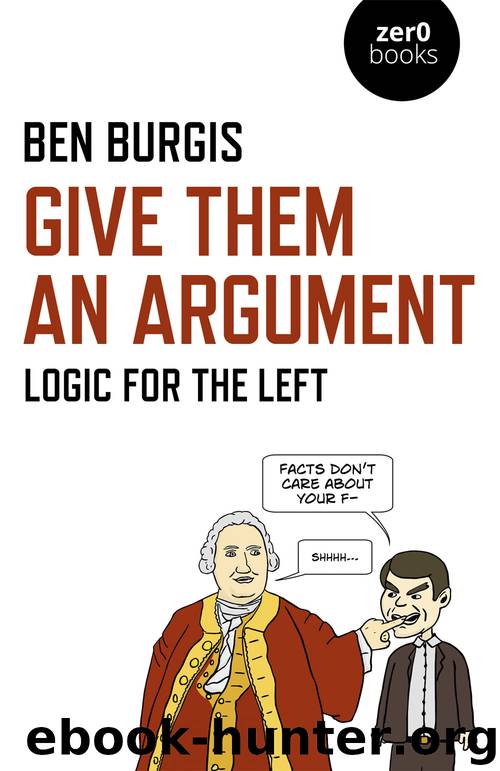Give Them an Argument by Ben Burgis;

Author:Ben Burgis;
Language: eng
Format: epub
ISBN: 9781789042115
Publisher: John Hunt (NBN)
Published: 2019-03-26T16:00:00+00:00
If the original statement P is true, the negated statement “not-P” is false and we write an “F” under the negation symbol. (If “snow is white” is true, “snow is not white” is false.) If P is false, “not-P” is true. (If “snow is green” is false, “snow is not green” is true.) Pretty simple.
Here’s the one for disjunction:
Here’s how to read this:
Each horizontal line represents one possible combination of P standing for something true, P standing for something false, Q standing for something true, or Q standing for something false. The truth value of the whole statement “Either P or Q” is written under the disjunction symbol in the middle. So, for example, on the two middle lines, one of the two disjuncts (i.e. one of the two things being “or”-ed) is true and the other is false, so the whole disjunction comes out as true and a little “T” is written under the disjunction symbol. (Think, “Either a Republican will win the 2020 election or a Democrat will win the 2020 election.” That’s almost certainly true, because even though one of the two disjuncts is false—we don’t know which one yet—the other will almost certainly be true.) The only line where the disjunction comes out false and a little “F” is written under the disjunction symbol is the line where “P” and “Q” are both false. (Think, “Either a Green Party candidate or a Libertarian Party candidate will win the 2020 election.”) But what about the top line?
Well, the “either…or” of ordinary English is ambiguous. Some disjunctions are inclusive (“P or Q or both”) and some are exclusive (“P or Q but not both”). The “∨” symbolizes inclusive disjunction, which is why the first line of the truth table above comes out as “true.” If you want to express the exclusive kind of disjunction in the language of symbolic logic, you write “(P ∨ Q) ∧ ¬(P ∧ Q).” As you might guess, “∧” is the conjunction symbol—“P ∧ Q” is just “P and Q.” This is the truth table for conjunction:
Download
This site does not store any files on its server. We only index and link to content provided by other sites. Please contact the content providers to delete copyright contents if any and email us, we'll remove relevant links or contents immediately.
| Anarchism | Communism & Socialism |
| Conservatism & Liberalism | Democracy |
| Fascism | Libertarianism |
| Nationalism | Radicalism |
| Utopian |
The Secret History by Donna Tartt(18058)
The Social Justice Warrior Handbook by Lisa De Pasquale(11930)
Thirteen Reasons Why by Jay Asher(8399)
This Is How You Lose Her by Junot Diaz(6401)
Weapons of Math Destruction by Cathy O'Neil(5779)
Zero to One by Peter Thiel(5444)
Beartown by Fredrik Backman(5293)
The Myth of the Strong Leader by Archie Brown(5204)
The Fire Next Time by James Baldwin(4987)
How Democracies Die by Steven Levitsky & Daniel Ziblatt(4933)
Promise Me, Dad by Joe Biden(4890)
Stone's Rules by Roger Stone(4819)
100 Deadly Skills by Clint Emerson(4647)
Rise and Kill First by Ronen Bergman(4528)
A Higher Loyalty: Truth, Lies, and Leadership by James Comey(4520)
The David Icke Guide to the Global Conspiracy (and how to end it) by David Icke(4348)
Secrecy World by Jake Bernstein(4342)
The Farm by Tom Rob Smith(4294)
The Doomsday Machine by Daniel Ellsberg(4221)
